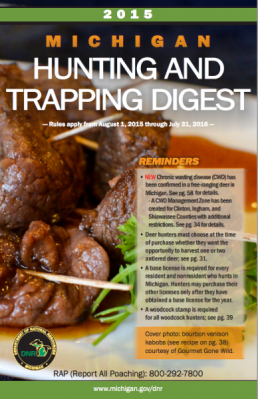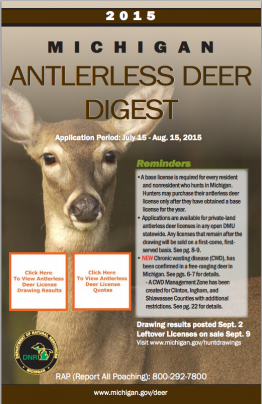Excerpts taken from for the DNR’s 2015 MICHIGAN DEER HUNTING PROSPECTS by Chad Stewart, Deer and Elk Program Specialist and Ashley Autenrieth Northern Regions Deer Biologist. To read the full article please visit www. michigan.gov/dnr.
The leading reason many individuals participate in deer hunting is simply the opportunity to spend time outdoors with friends and family, but actually harvesting a deer is still very important to many deer hunters. No amount of hunting guarantees a harvest, but preparation and hard work are keys to producing the best chance to see and take deer, or to mentor a new hunter through a safe and enjoyable season. The 2015 deer season is expected to be a successful year for many hunters, and as always, will certainly offer the exciting challenge we call ‘hunting’.
Persistence can pay off for deer hunters. Nationwide, successful deer hunters hunt an average of 18 days – slightly more than the average of about 14 days that Michigan deer hunters spent afield last year. However, chances for success are greatest for those who are prepared. Part of hunting preparations each year includes becoming familiar with the most recent regulations. The deer website of the Michigan Department of Natural Resources (DNR) – www.michigan.gov/deer – provides highlights of regulation changes, information about deer management, and links to additional resources, such as a list of deer check stations.
Some successful hunting trips are just a result of being in the right place at the right time. Overall, deer activity tends to be highest a few weeks prior to breeding. The peak of breeding activity for Michigan deer generally occurs just prior to the opening of the firearm deer season. These peak breeding dates are earliest in the southern Lower Peninsula, except that many does in the region that were born just this spring will already conceive their first fawns this year. Those breeding events for young does often occur a month or more later than they do for older deer, often not until mid-December. Hunters often seek to take advantage of these times of high deer movements, so archery hunting activity is often highest in late October and early November, followed by the busiest deer hunting day of the year — the opening of the firearm season. In southern Michigan, another late period of deer activity can occur several weeks prior to the late breeding events among young does, which can coincide with the end of the firearm season.

The 2015 deer season is forecasted to have similar to slightly increased success rates to last year. Please see below for more detailed information about the area you hunt and what to expect. Though, this may help to get you started with what to look for there is no substitute for scouting. The opportunity to find out which trees are producing, what deer trails are being utilized and what patterns deer are following this year is priceless information for a deer hunter. So, whether your goal is to get meat in the freezer, go for a wall hanger or simply get outdoors, Michigan’s deer seasons offer something for everyone.
NORTHERN LOWER PENINSULA
The deer population for the Northern Lower Peninsula (NLP) is expected to be on the increase in comparison to last year. Even with the severe winter this past year deer in the NLP came through it in fair to good condition.
Deer sightings have been good throughout the region and many have reported seeing healthy fawns including many sets of twins and even some triplets. Though it appears some deer may have been lost due to the severe winter the main impacts observed from winter will likely be smaller body size and/or antlers rather than lower populations.
Mast production (fruits and nuts) has been spotty throughout the region. For the second year in a row high production of apples are being reported. Acorn and beechnut production is diverse with some areas seeing decent production and others reporting none. Deer should be targeting the producing areas frequently. Scouting to find these areas will be very important. Contacting your local wildlife office may be a good first step; they may be able to give you insight as to which areas are producing.
Expect to see similar to increased deer numbers compared to last year throughout most of the NLP. Many areas may see more 2.5 year old bucks this year as well since a number of NLP counties began a 3 point antler point restriction in 2013 which allowed the majority of 1.5 year old bucks to mature to the next age class this year. All NLP Deer Management Units are open for antlerless hunting so be sure to look in the 2015 Antlerless Deer Digest if you are interested in obtaining an antlerless license.
SOUTHERN LOWER PENINSULA
Abundant food and cover in the form of agricultural crops and scattered swamps and woodlots provide very good habitat across the southern Michigan landscape. This high quality habitat, combined with relatively mild winter conditions, typically results in a more abundant and productive deer population compared to other regions of the state.
Over the last decade or more, deer population estimates and indices (including deer/vehicle collisions, crop damage complaints, and observations of deer by the hunting community and field staff) in the Southern Lower Peninsula have stabilized or declined. In many instances, reductions were intended to reduce conflicts that can occur when deer populations are high, though the Department still desires to keep adequate deer for enjoyable hunting and viewing experiences. Repeated outbreaks of Epizootic Hemorrhagic Disease (EHD), however, have also occurred over this period. Though individual EHD outbreak sites affect deer at the scale of a township or smaller, these outbreaks have likely produced more variability in deer densities across southern Michigan than has occurred in many years. Management efforts are now being directed towards distinct areas at a smaller scale rather than larger. Research is underway to improve understanding of the duration of EHD impacts that hunters and landowners should expect to see where outbreaks have occurred. Given the higher proportion of land in private ownership in this region, and the often small property sizes, the Department is working to find more ways to support good deer harvest and habitat management decisions among networks of private landowners and hunters.
WHERE TO HUNT
As any deer hunter knows deer are not stationary animals, they are constantly moving to new places and just as often, they are returning to familiar spots. Michigan’s deer herd is no exception. It is spread out across the state and often, locally pocketed in areas with the best habitat and resources available. For this reason there is no better way to locate deer than by getting out on the landscape and scouting. Learning where this year’s deer trails are, finding which oak trees are producing acorns and discovering where a group is bedding down each night are often the keys to a successful hunt. Michigan also offers a number of online interactive tools such Mi-HUNT, an interactive web application located at www.michigan. gov/mihunt, to help you hone in on good habitat and potential hunting spots. If you find yourself short on time these tools are an excellent way to save some time and narrow down your selection.
CONSIDER MENTORING A YOUTH HUNTER
Shared experience with family and friends is one of the most cherished aspects of hunting. We encourage you to share that heritage with a young person in your life. Under the Mentored Youth Hunting Program it is possible to take a youth 9 or younger deer hunting. For specific program requirements please visit: www.
michigan.gov/mentoredhunting
MICHIGAN SPORTSMEN AGAINST HUNGER PROGRAM
The Michigan Sportsmen Against Hunger (MSAH) program is a wonderful way for hunters to share a part of their harvest this fall, or donate a whole deer. Since 1991, MSAH has been working to help connect donors, wild game processors and charities that feed needy individuals. Together, they have assembled a network of processors and charities to help channel wild game donations into the hands of those in need. If interested in donating please contact your local field office.
BRING YOUR DEER TO A CHECKSTATION
Michigan has some of the best historical data on deer in the country. The data we gather at checkstations and from the hunter harvest surveys helps us to make future management decisions, monitor the health of the herd and the time spent talking with hunters is invaluable to field staff. You can be a part of this important aspect of deer management by bringing your deer or deer head to a checkstation, along with information about where and when the deer was taken. As always, you also receive a successful hunter deer management cooperator patch. Please see our Deer Checkstation List on the website for locations and hours.
ANTLER POINT RESTRICTIONS
A number of different antler point restrictions, or APRs, have been implemented in Michigan in recent years, and other areas have received consideration for APRs. No new proposals have been submitted and there are not any currently being
considered for implementation in the next few seasons. The only change made to APR regulations was the removal of the 4 points on a side rule on the restricted combination license for DMU 333. This was done to help encourage hunters to harvest deer and have them tested for CWD so that the Department may determine how prevalent the disease may be within the wild deer population.
See the 2015 Hunting and Trapping Digest pages 32 & 33 for complete information on these regulations. You may also visit the APR Corner page located at www.michigan. gov/deer for more information and history on APRs in Michigan.

